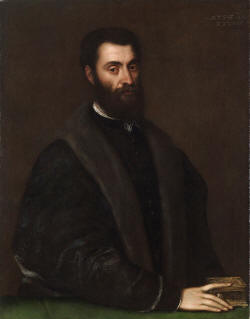

Queer Places:
Via Sperone Speroni, 35141 Padova PD
Duomo di Padova, Piazza Duomo, 35139 Padova PD
 Sperone Speroni ( Padua , 12 April 1500 - Padua , 2 June 1588 ) was a writer and philosopher Italian .
A fake epitaph circulating after his death, seemed to hint to Speroni's homosexuality:
Qui giace in asso Speronel dottore,
sofista espresso e finto puttaniero,
sodomita, protervo e barattiero,
della sede di Cristo distruttore. (Here lies Speronel doctor in the lurch,
express sophist and fake whorehouse holder,
sodomite, arrogant and barter,
of the seat of Christ the destroyer.)
Sperone Speroni ( Padua , 12 April 1500 - Padua , 2 June 1588 ) was a writer and philosopher Italian .
A fake epitaph circulating after his death, seemed to hint to Speroni's homosexuality:
Qui giace in asso Speronel dottore,
sofista espresso e finto puttaniero,
sodomita, protervo e barattiero,
della sede di Cristo distruttore. (Here lies Speronel doctor in the lurch,
express sophist and fake whorehouse holder,
sodomite, arrogant and barter,
of the seat of Christ the destroyer.)
He was born in the ancient Paduan Speroni degli Alvarotti family in the ancient family palace in Contrà Sant'Anna. His father Bernardino was Pope Leo X's archiatrist , his mother Lucia was an exponent of the Contarini . Child prodigy in his studies, he became professor of logic at the University of Padua at the age of eighteen. After a few years of teaching, however, he decided to deepen his studies in Bologna, under the famous Aristotelian philosopher Pietro Pomponazzi . On his death in 1525, he returned to Padua where he taught for another three years, until the death of his father; after that he had to actively look after his family. The composition of the dialogues that will be published by his friend Daniele Barbaro in 1542, with the title of Dialogi, dates back to this period : they are the Dialogue of love , that of the Dignity of women , that of The time to give birth to women and that of Family care , the two lucianei dialogues of the Usury and of the Discordy , followed by that of the Languages and that of the Rhetoric , and finally that of the Laudi del Catajo, Villa of S. Beatrice Pia degli Obici and the one titled Panico e Bichi. These dialogues are Speroni's best-known works, although they were published without his knowledge and were never recognized, and have had dozens of reprints during the sixteenth century. The composition of the Dialogue of active and contemplative life also dates back to this period , but it was not included in the Dialogi of '42, for reasons still unknown. Member of the Accademia degli Infiammati and friend of Torquato Tasso, he took care of the revision of the Gerusalemme Liberata . He was the author of Canace , published in Venice in 1546, a tragedy that will follow a heated controversy between the author and Giambattista Giraldi Cinzio . Later he also intervened in the controversy between Giraldi Cinzio himself and Giovan Battista Pigna regarding the Orlando furioso and the novel as a literary genre . In 1560 he moved to Rome where he became friends with Annibal Caro . Back in Padua he composed the Discourses on Dante, on the Eneide, on Orlando furioso and the Dialogue of history . He was the advocate of an even more extreme classicism than that of Giangiorgio Trissino from Vicenza , whom he reproached for having drawn the subject of his Sofonisba from history and not from mythology . In accordance with the Greek custom and, of course, in full respect of the Aristotelian units , he was inspired by Ovid's Heroides for Canace . He died at the age of 88. He was buried in the Cathedral of Padua in the Alvarotti tombs. In the passage of the northern gate a monument was later erected by Girolamo Campagna .
My published books: